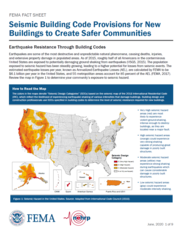|
|
Earthquakes are some of the most destructive and unpredictable natural hazards. Each year thousands of new residential homes and other buildings are constructed in high and very high seismic hazard areas, and the population exposed to seismic hazard has been steadily growing.
|
|
- The annualized earthquake losses are estimated at $6.1 billion per year in the U.S.
- 55 metropolitan areas account for 85 percent of those potential losses.
|
|
As the population exposed to seismic hazard steadily grows, there will be a higher potential for losses from seismic events.
|
|
|

Although we can’t prevent earthquakes from striking communities where people work and live, we can take action to impact the most important factor in saving lives and reducing losses from an earthquake: adopting and enforcing latest national model building codes. The FEMA National Earthquake Hazards Reduction Program (NEHRP) is excited to release the Seismic Building Code Provisions for New Buildings to Create Safer Communities Fact Sheet. This fact sheet illustrates the levels of seismic hazard for potential building damage within the U.S., shows readers how incorporating seismic building codes into buildings can save lives and prevent losses from earthquakes, and provides the current seismic building code adoption status information in high and very high seismic hazard regions in the nation.
Seismic-resistant building codes minimize the likelihood of building collapse and provide higher protection and seismic damage reduction for critical facilities like hospitals and essential public utility structures, as well as for schools and storage buildings containing hazardous materials.
New buildings that are compliant with the most recent editions of national model building codes (e.g. International Building Code (IBC) and International Residential Code (IRC)) and the reference design standard (e.g. ASCE/SEI 7 Minimum Design Loads and Associated Criteria for Buildings and Other Structure) are more resilient than buildings that don’t use any building code or use outdated and inadequate building codes. Several FEMA programs help to encourage or support states and local communities to adopt and enforce the latest national model building codes. By incorporating modern, up-to-date building codes into buildings, we will build a stronger community that can withstand the harsh effects of earthquakes.
For more information, visit the FEMA NEHRP Program: https://www.fema.gov/national-earthquake-hazards-reduction-program
|
|
|
|
|